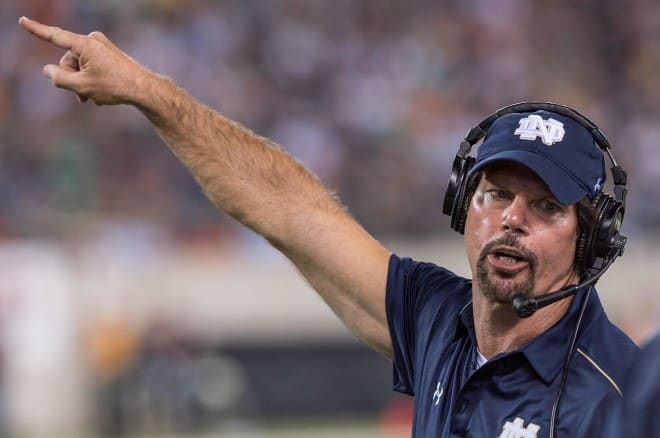Brian VanGorder: Notre Dame Defense Is ‘Likeable And Learnable’

Brian VanGorder has heard the theories and accusations of his NFL defense being too complex for college student-athletes. He understands them, too — even if he doesn’t necessarily agree with them.
“Our players that are dialed into it, it’s pretty consistent for them,” the third-year Fighting Irish defensive coordinator said while meeting with the media Wednesday morning. “Now, I’m not saying that a player that comes here and plays in our defense … he’s going to put a lot of tools in his toolbox — but it’s not just wild tools thrown from all over. It’s pretty consistent for the players. It’s likeable and it’s learnable. That’s how we approach it. We have smart players.”
VanGorder was forthright about acknowledging that the 2015 Notre Dame defense was not up to standards, especially with so many veterans, so consequently there is going to be a natural cause and effect connotation and backlash. The complexity of the defense is seen as the cause, and the inconsistent or disappointing results are the effect.
“It’s because we have a large inventory, I guess,” VanGorder said of the popular theory that his defense creates information overload amongst the players, or at least in some of them. “And we didn’t play real good defense, right? If you have a large inventory and don’t play real good defense, then that’s the assumption. That’s true in athletics, that’s true in competition. That’s just the way it goes.
“If you don’t do well, you’re going to hear those different things that come out. But within our room, we know the truth, what we’ve got to do. Like I said, our stuff is likeable and learnable. It’s fun to play in our system.”
While engaging in the self-scouting since the end of last season, plenty of upgrades also were found from VanGorder’s first campaign in 2014, when injuries pretty much limited the defense to a skeletal version by the final month. Adjusting to no-huddle, up-tempo offenses improved in 2015, as did third-down efficiency and producing more three-and-out series.
However, there are three areas that VanGorder and the defensive staff are concentrating their attention on this spring. First is coming out of the gates much stronger. In its three losses last season, Notre Dame:
• Fell behind 14-0 at Clemson with 8:43 still left in the first quarter.
• Yielded 75- and 78-yard touchdown drives at Stanford while finding itself down 14-7 in the first quarter (with a CJ Sanders kickoff return in between the lone Irish score).
• Trailed 14-0 after 80- and 43-yard drives by Ohio State in the Fiesta Bowl with 7:41 still remaining in the first quarter.
This is not including surrendering a three-play, 70-yard touchdown drive in the first series versus Navy, USC going for 71 yards in eight plays for a TD after the opening kickoff the next week, or even UMass tallying 20 first-half points at Notre Dame, mainly on explosive plays.
“We’re going to do more things to start practice, some faster paced things to kind of make sure they’re awake and ready,” VanGorder said. “I don’t want to say that was the problem — we just didn’t do a good job. I don’t have a good reason. There were some explosive-play scenarios — an explosive play against Clemson to start the game … a leverage breakdown.
“There’s not a good explanation, but this is what I do know: the more we emphasize it, the more important it becomes. It’s got to be an emphasis and then it’s got to be a method to it. Part of that is as we start practice to do some things where they have to focus real quickly and get after it, not just a typical warm-up session.”
A second major problem is permitting way too many explosive plays, which goes back to potentially some confusion or miscommunication problems on defense.
“Our explosive play count — while somewhere in the middle of the pack respective to the country — was really bad relative to big-play touchdowns and long, long yardage,” VanGorder said. “That was a major issue.
“The explosive plays … that’s a difficult thing. I just think that the combination of players playing better and coaches coaching better, that’s what’s got to happen. In the challenges we’ve faced at least since I’ve been here, we’ve been able to improve in areas, and the emphasis part by us should help. We’ve got to get it solved.”
Finally, there is red-zone defense — which has been overshadowed by Notre Dame’s red-zone offense woes, including have committed the most turnovers inside an opponent’s 20-yard line the past two years combined. In 2014, opposing offenses scored touchdowns versus the Fighting Irish 70.0 percent of the time in the red zone (35 of 50) for a No. 116 ranking. It wasn’t much better in 2015 at 65.9 percent (27 of 41), most notably Stanford tallying five touchdowns in its five red-zone chances.
“We started red zone today,” VanGorder said after the sixth practice this spring. “Those three things to me would be really critical moving forwards.”